
List of Thai ingredients
Encyclopedia
This is a list of selected ingredients found in Thai cuisine.
See also: List of Thai dishes.
See also: List of Thai dishes.
Fresh herbs and spices
| Image | Thai name Royal Thai General System of Transcription The Royal Thai General System of Transcription is the official system for rendering Thai language words in the Latin alphabet, published by the Royal Institute of Thailand... |
Thai script | English name | Description and use |
|---|---|---|---|---|
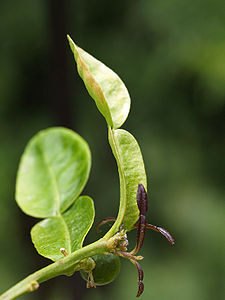 |
Bai makrut | ใบมะกรูด | Kaffir lime Kaffir lime The kaffir lime, Citrus × hystrix, Rutaceae), is also known as combava, kieffer lime, limau purut, jeruk purut or makrut lime,... leaves |
Kaffir lime leaves are widely used in spicy Thai soups and curries, either cooked whole, together with the dish, and/or finely shredded and added before serving. |
_leaves.jpg) |
Bai toei | ใบเดย | Pandan Pandanus amaryllifolius Pandanus amaryllifolius is a tropical plant in the screwpine genus which is known commonly as pandan and is used widely in Southeast Asian cooking as a flavoring. The plant is rare in the wild but is widely cultivated. It is an upright green plant with fan-shaped sprays of long, narrow, bladelike... or screwpine leaves |
This sweet smelling leaf is used in different sweet snacks. It is also used in the well known dish Kai ho bai toei, deep fried chicken wrapped in pandanus leaves, as well as to stuff the belly of barbecued fish |
| Bai yanang | ใบย่านาง | Tiliacora triandra Tiliacora triandra Tiliacora triandra is a species of flowering plant native to mainland Southeast Asia and used particularly in the cuisines of northeast Thailand and Laos. In the Isan language, it is called bai yanang or bai ya nang , or simply yanang or ya nang . In Laos, it is also called bai yanang... |
Leaves used in the preparation of Kaeng no mai som , sometimes called Kaeng Lao . | |
| Horapha | โหระพา | Thai sweet basil Thai basil Thai basil is a type of sweet basil native to Southeast Asia that has been cultivated to provide a distinctive set of traits. It has an identifiable licorice flavor not present in sweet basil, and its flavor is more stable under high or extended cooking temperatures than that of sweet basil... |
A variety of the sweet basil with a taste of anise Anise Anise , Pimpinella anisum, also called aniseed, is a flowering plant in the family Apiaceae native to the eastern Mediterranean region and Southwest Asia. Its flavor resembles that of liquorice, fennel, and tarragon.- Biology :... . It is used in different curries such as red Red curry Red curry is a popular Thai dish consisting of curry paste to which coconut milk is added. The base is properly made with a mortar and pestle, and remains moist throughout the preparation process. The main ingredients are garlic, shallots, red chili peppers, galangal, shrimp paste, salt, kaffir... and green curry Green curry Green curry is a variety of curry in Thai cuisine. The name "green" curry derives from the color of the dish. Other Thai curry dishes are identified solely by their colors, such as yellow and red curry. Green curries tend to be as hot as red curries, both being hotter than phanang/padang curries... and often also served separately. |
|
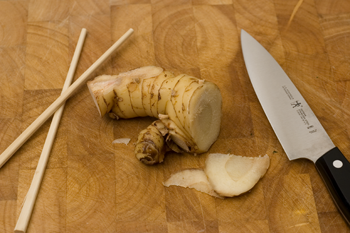 |
Kha | ข่า | Galangal Galangal Galangal is a rhizome of plants of the genus Alpinia or Kaempferia in the ginger family Zingiberaceae, with culinary and medicinal uses originated from Indonesia... |
The perfume-like scent and flavour of the galangal root is characteristic for many Thai curries and spicy soups. |
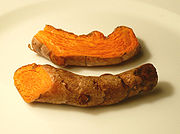 |
Kha min | ขมิ้น | Turmeric Turmeric Turmeric is a rhizomatous herbaceous perennial plant of the ginger family, Zingiberaceae. It is native to tropical South Asia and needs temperatures between 20 °C and 30 °C and a considerable amount of annual rainfall to thrive... |
This yellow coloured root is often used in dishes of Muslim/Southern Thai origin and in Northern Thailand for Northern style curries. |
 |
Khing | ขิง | Ginger Ginger Ginger is the rhizome of the plant Zingiber officinale, consumed as a delicacy, medicine, or spice. It lends its name to its genus and family . Other notable members of this plant family are turmeric, cardamom, and galangal.... |
Either served raw (shredded or diced) with dishes such as Miang kham and Khanom chin sao nam, in certain chilli dips, or in stir fried dishes of Chinese origin. |
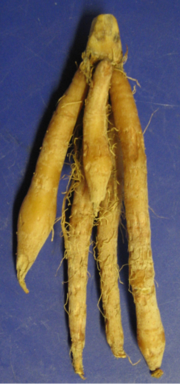 |
Krachai | กระชาย | Fingerroot | This root has a slightly medicinal flavour and is used in certain fish dishes and curries. |
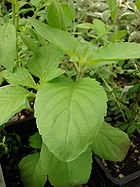 |
Kraphao | กะเพรา | Holy basil | Holy basil has a distinctive scent of clove and reddish tipped leaves. It is used, for instance, in the well-known Kraphao mu (minced pork fried with basil). |
| Krathiam | กระเทียม | Garlic Garlic Allium sativum, commonly known as garlic, is a species in the onion genus, Allium. Its close relatives include the onion, shallot, leek, chive, and rakkyo. Dating back over 6,000 years, garlic is native to central Asia, and has long been a staple in the Mediterranean region, as well as a frequent... |
Besides being used cooked or fried, garlic is used raw in many dips and salad dressings. It is also served raw on the side with several Thai dishes such as Khao kha mu (stewed pork served on rice) or as one of the ingredients for dishes such as Miang kham. | |
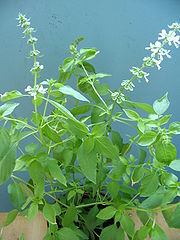 |
Maenglak | แมงลัก | Lemon basil Lemon basil Lemon basil is a hybrid between basil and African basil .It is an herb grown primarily in northeastern Africa and southern Asia, for its strong fragrant lemon scent is used in cooking.... |
The leaves are used in certain curries. It is also indispensable with Khanom chin nam ya. The seeds resemble frog's eggs when soaked in water and are used in sweet desserts. |
| Phak chi | ผักชี | Coriander Coriander Coriander is an annual herb in the family Apiaceae. Coriander is native to southern Europe and North Africa to southwestern Asia. It is a soft, hairless plant growing to tall. The leaves are variable in shape, broadly lobed at the base of the plant, and slender and feathery higher on the... /cilantro leaves |
The leaves are seen often as a garnish with many Thai dishes. It is indispensable for Tom yam soup. | |
 |
Phak chi farang | ผักชีฝรั่ง | Culantro | A herb often seen in spicy soups and Northern curries. It literally means "European coriander", perhaps because it was brought from the Caribbean Caribbean The Caribbean is a crescent-shaped group of islands more than 2,000 miles long separating the Gulf of Mexico and the Caribbean Sea, to the west and south, from the Atlantic Ocean, to the east and north... to Thailand by Europeans. |
| Phak chi Lao | ผักชีลาว | Dill Dill Dill is a perennial herb. It is the sole species of the genus Anethum, though classified by some botanists in a related genus as Peucedanum graveolens C.B.Clarke.-Growth:... |
Fresh dill is used mainly in certain soups and in curries from north-eastern Thailand which do not contain coconut milk. It literally means "coriander from Laos" in Thai. | |
| Phak phai | ผักไผ่ | Vietnamese coriander Vietnamese coriander Persicaria odorata, the Vietnamese coriander, is an herb whose leaves are used in Southeast Asian cooking. Other English names for the herb include Vietnamese mint, Vietnamese cilantro, Cambodian mint and hot mint. The Vietnamese name is rau răm, while in Malaysia and Singapore it is called daun... |
The Persicaria odorata is used sparingly in Thai cuisine. It is indispensable with Lap lu, a Northern Thai dish of raw minced pork, beef or buffalo, and blood, with spices, herbs and leaves. | |
| Phrik chi fa | พริกชี้ฟ้า | Jalapeño Jalapeño The jalapeño is a medium-sized chili pepper that has a warm, burning sensation when eaten. A mature jalapeño fruit is 2–3½ inches long and is commonly picked and consumed while still green, but occasionally it is allowed to fully ripen and turn crimson red... pepper |
A medium sized chilli and less spicy than the phrik khi nu, it is often added to stir fried dishes and curries as a kind of 'vegetable'. Either red, yellow or green in colour. | |
 |
Phrik khi nu | พริกขี่หนู | Bird's eye chilli | This small chilli is one of the spiciest and used extensively in Thai cooking. The Thai name literally translates to "mouse-dropping chilli" |
| Phrik khi nu suan | พริกขี่หนูสวน | This variety of the phrik khi nu is even smaller and even more spicy. The name literally translates to "garden mouse-dropping chilli". | ||
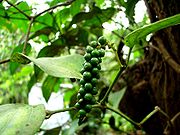 |
Phrik Thai on | พริกไทยอ่อน | Fresh peppercorns | Thai cuisine often uses fresh (green) peppercorns in stir fried dishes and in certain curries such as Kaeng pa (so-called Jungle Curry Jungle Curry Jungle Curry is a variety of Thai curry traditionally from the northern jungles of Thailand. As coconuts are not found in these jungles Jungle Curry contains no coconut milk , making it more suitable for those on low saturated fat diets... ). |
| Phrik yuak | พริกหยวก | Wax pepper | Very large, mild tasting pale-green chillies which can be found in certain stir fried dishes or deep fried stuffed with, for instance, pork. | |
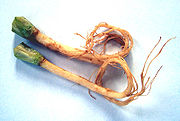 |
Rak phak chi | รากผักชี | coriander Coriander Coriander is an annual herb in the family Apiaceae. Coriander is native to southern Europe and North Africa to southwestern Asia. It is a soft, hairless plant growing to tall. The leaves are variable in shape, broadly lobed at the base of the plant, and slender and feathery higher on the... /cilantro root |
The roots of the coriandrum sativum are often used in curry pastes and certain soups such as Tom yam kung. |
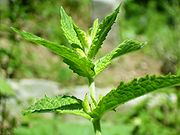 |
Saranae | สะระแหน่ | Spearmint Spearmint Mentha spicata syn. M. cordifolia is a species of mint native to much of Europe and southwest Asia, though its exact natural range is uncertain due to extensive early cultivation. It grows in wet soils... |
Used in many Thai salads and sometimes as a way to suppress the 'muddy' taste of certain fish when steamed. |
 |
Takhrai | ตะไคร้ | Lemon grass | Used extensively in many Thai dishes such as curries, spicy soups and salads. |
Dried herbs and spices
| Image | Thai name Royal Thai General System of Transcription The Royal Thai General System of Transcription is the official system for rendering Thai language words in the Latin alphabet, published by the Royal Institute of Thailand... |
Thai script | English name | Description and use |
|---|---|---|---|---|
 |
Kanphlu | กานพลู | Clove Clove Cloves are the aromatic dried flower buds of a tree in the family Myrtaceae. Cloves are native to the Maluku islands in Indonesia and used as a spice in cuisines all over the world... s |
Used in certain meat dishes, most notably in Matsaman curry. |
 |
Luk chanthet | ลูกจันทน์เทศ | Nutmeg Nutmeg The nutmeg tree is any of several species of trees in genus Myristica. The most important commercial species is Myristica fragrans, an evergreen tree indigenous to the Banda Islands in the Moluccas of Indonesia... nut |
Used in certain Indian style curries, most notably in Matsaman curry. |
 |
Nga | งา | Sesame Sesame Sesame is a flowering plant in the genus Sesamum. Numerous wild relatives occur in Africa and a smaller number in India. It is widely naturalized in tropical regions around the world and is cultivated for its edible seeds, which grow in pods.... seed |
The oil from the sesame seed is not really used in Thai cuisine (unlike in Chinese cuisine). The seeds (black and white sesame) are mainly used whole in certain deep fried desserts such as thong muan . |
 |
Opchoei | อบเชย | Cassia cinnamon | Used in certain meat dishes, most notably in Matsaman curry. |
| Phong kari | ผงกะหรี่ | Curry powder Curry powder Curry powder is a mixture of spices of widely varying composition based on South Asian cuisine. Curry powder, and the contemporary English use of the word curry are Western inventions and do not reflect any specific Indian food, though a similar mixture of spices used in north India is called... |
Thai curries are nearly always made with fresh pastes. Curry powder is only used when making certain Indian style curries. | |
| Phong phalo | ผงพะโล้ | Five-spice powder Five-spice powder Five-spice powder is a mixture of five spices endemic to Chinese cuisine, but also used in other Asian cookery as well.-Formulae:The formulae are based on the Chinese philosophy of balancing the yin and yang in food. There are many variants. The most common is bajiao , cloves, cinnamon, huajiao ... |
The Chinese five-spice powder is used mainly in Thai-Chinese dishes such as mu phalo (pork stewed in soy sauce) | |
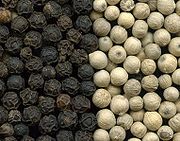 |
Phrik Thai | พริกไทย | Black pepper Black pepper Black pepper is a flowering vine in the family Piperaceae, cultivated for its fruit, which is usually dried and used as a spice and seasoning. The fruit, known as a peppercorn when dried, is approximately in diameter, dark red when fully mature, and, like all drupes, contains a single seed... |
|
 |
Phrik Thai khao | พริกไทยขาว | White pepper White Pepper -Singles:* "Even If You Don't" was released as a single on Mushroom Records with the B-side "Cornbread Red".* "Stay Forever" was released as a single on Mushroom Records with "The Grobe" and "Who Dat?"-Musicians featured on the record:* Dean Ween* Gene Ween... |
|
Pastes, sauces and condiments
| Image | Thai name Royal Thai General System of Transcription The Royal Thai General System of Transcription is the official system for rendering Thai language words in the Latin alphabet, published by the Royal Institute of Thailand... |
Thai script | English name | Description and use |
|---|---|---|---|---|
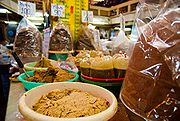 |
Kapi | กะปิ) | Thai shrimp paste Shrimp paste Shrimp paste or shrimp sauce, is a common ingredient used in Southeast Asian and Southern Chinese cuisine. It is known as terasi in Indonesian, ngapi in Burmese, kapi in Thai, Khmer and Lao language, belacan in Malay, mắm ruốc, mắm tép and mắm tôm in... |
Made by fermenting ground shrimp and salt. it has a pungent aroma. It is used, for instance, in red curry paste, in the famous chili paste called nam phrik Nam phrik Nam phrik , generally pronounced "Nam phik", is a generic term that may refer to any of the types of more or less thick spicy, often chili based, hot sauces typical of Thai cuisine. The main ingredients of Nam phrik are fresh or dry chilies, garlic, shallots, fish sauce, lime juice and/or some kind... kapi. |
| Khrueang kaeng | เครื่องแกง | Thai curry paste | Literally meaning "curry ingredients", Thai curry paste can be made fresh at home or bought freshly made at markets in Thailand or pre-packaged for export markets. Most khrueang kaeng will be a ground mixture of fresh or dried chillies, various spices and herbs and other ingredients such as shrimp paste. | |
| Nam man hoi | น้ำมันหอย | Oyster sauce Oyster sauce Oyster sauce describes a number of sauces made by cooking oysters. The most common in modern use is a viscous dark brown condiment made from sugar, salt and water thickened with cornstarch, flavoured with a little oyster essence or extract and some versions may be darkened with caramel, though high... |
Oyster sauce is of Chinese origin. It is used extensively in vegetable and meat stir-fries. | |
 |
Nam pla | น้ำปลา | Fish sauce Fish sauce Fish sauce is a condiment that is derived from fish that have been allowed to ferment. It is an essential ingredient in many curries and sauces. Fish sauce is a staple ingredient in numerous cultures in Southeast Asia and the coastal regions of East Asia, and features heavily in Thai and Vietnamese... |
Thai fish sauce is a very aromatic and strong tasting fish sauce which can be made from different types of fish and seafood. Fish sauce is a staple ingredient in Thai cuisine and imparts a unique character to Thai food. |
| Pla ra Pla ra Pla ra is fermented fish sauce, popular in Northeastern Thai cuisine.It is made by pickling several varieties of fish, mainly Snakehead Murrel . The fish is cleaned and cut into pieces, after which it is mixed with salt and rice bran... |
ปลาร้า | Also a sauce made from fermented fish. It is more pungent than nam pla, and, in contrast to nam pla which is a clear liquid, pla ra is opaque and still contains pieces of fish. | ||
| Si-io dam | ซีอิ้วดำ | Dark soya sauce | Thai "dark" soya sauce is similar to the dark Chinese soya sauce. | |
| Si-io khao | ซีอิ้วขาว | Light soya sauce | Thai "light" soya sauce is similar to the light Chinese soya sauce. | |
| Taochiao | เต้าเจี้ยว | Yellow soybean paste Yellow soybean paste Yellow soybean paste is a fermented paste made from yellow soybeans, salt, and water; wheat flour, though not formerly used, is often used as an additional ingredient in the modern day, and potassium sorbate may also be used as a preservative... |
Yellow soybean paste has a sweet-and-salty taste which is more "earthy" than that of soya sauce.It is used, for instance, in the dish Phak bung fai daeng (stir-fried water spinach). | |
Vegetables
| Image | Thai name Royal Thai General System of Transcription The Royal Thai General System of Transcription is the official system for rendering Thai language words in the Latin alphabet, published by the Royal Institute of Thailand... |
Thai script | English name | Description and use |
|---|---|---|---|---|
 |
Buap hom | บวบหอม | Luffa aegyptiaca Luffa aegyptiaca Luffa aegyptiaca is a species of Luffa. Commonly known as Smooth Luffa, Egyptian Luffa and mướp hương in Vietnamese, sometimes under the obsolete name Luffa cylindrica and frequently misspelled "Luffa aegyptica", it is cultivated and grown for its fruit. The fruit resembles a cucumber... |
Used in stir-fries, in curries and in Kaeng type soups. |
 |
Buap liam | บวบเหลี่ยม | Luffa acutangula Luffa acutangula Luffa acutangula is a species of Luffa. It is commercially grown for its unripe fruits as a vegetable. Mature fruits are used to make cleaning sponges. Its fruit slightly resembles a cucumber with ridges. It ranges from central Asia and eastern Asia to southeastern Asia... |
Used in stir-fries and in Kaeng type soups. |
| Cha plu | ชะพลู | Piper sarmentosum Piper sarmentosum Piper sarmentosum is a plant in the Piperaceae family used in many Southeast Asian cuisines. The leaves are often confused with betel, but they lack the intense taste of the betel leaves and are significantly smaller.-Names:... |
This leaf is used raw as a wrapper for the Thai dish Miang kham. | |
 |
Fak thong | ฟักทอง | Pumpkin Pumpkin A pumpkin is a gourd-like squash of the genus Cucurbita and the family Cucurbitaceae . It commonly refers to cultivars of any one of the species Cucurbita pepo, Cucurbita mixta, Cucurbita maxima, and Cucurbita moschata, and is native to North America... |
Used in curries, stir-fries, soups, salads and sweets. |
| Khilek | ขี้เหล็ก | Senna siamea Senna siamea Senna siamea , also known as Kassod Tree or Cassod Tree, is a legume in the subfamily Caesalpinioideae. It is native to South and Southeast Asia, although its exact origin is unknown.... |
The leaves, tender pods and seeds are edible, but they must be previously boiled and the water discarded. One of the most well-known preparations is Kaeng khilek (แกงขี้เหล็ก). | |
| Makhuea phuang | มะเขือพวง | Pea eggplant Solanum torvum Solanum torvum , is a bushy, erect and spiny perennial plant used horticulturally as a rootstock for eggplant. Grafted plants are very vigorous and tolerate diseases affecting the root system, thus allowing the crop to continue for a second year.It is also known as Devil's Fig, Prickly Nightshade,... |
This pea sized eggplant is often used in curries and is indispensable in Nam phrik kapi, a chilli dip containing shrimp paste Shrimp paste Shrimp paste or shrimp sauce, is a common ingredient used in Southeast Asian and Southern Chinese cuisine. It is known as terasi in Indonesian, ngapi in Burmese, kapi in Thai, Khmer and Lao language, belacan in Malay, mắm ruốc, mắm tép and mắm tôm in... , where it is used raw. |
|
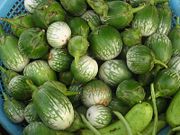 |
Makhuea pro | มะเขือเปราะ | Thai eggplant Thai eggplant The Thai eggplant is a variety of eggplant used primarily in Thai cuisine. The most common eggplants in Thai cooking are the round white or green ones about the size of a golf ball. Common cultivar types in Thailand are Thai Purple, Thai Green, Thai Yellow, and Thai White.Thai eggplants are... |
About the size of a ping pong ball, these eggplants are used in curries or stir-fries, but they are also eaten raw with Nam phrik (Chilli dips). |
| Makhuea thet | มะเขือเทศ | Tomato Tomato The word "tomato" may refer to the plant or the edible, typically red, fruit which it bears. Originating in South America, the tomato was spread around the world following the Spanish colonization of the Americas, and its many varieties are now widely grown, often in greenhouses in cooler... |
Literally meaning "foreign eggplant", it is used in salad such as Som tam Som tam Som tam or som tum also known as tam bak hung is a spicy salad, the standard form of which is made from shredded unripened papaya. Som tam is similar to the Laotian dish tam mak hung and the Cambodian dish bok l'hong... , as an ingredient in stir-fries such as in Thai fried rice, but also cooked to a thick sauce as in the chilli paste Nam phrik ong. |
|
| Mara | มะระ | Bitter melon Bitter melon Momordica charantia, called bitter melon or bitter gourd in English, is a tropical and subtropical vine of the family Cucurbitaceae, widely grown in Asia, Africa, and the Caribbean for its edible fruit, which is among the most bitter of all fruits... or bitter gourd |
The small variety is most often eaten raw with Nam phrik. Popular is Tom chuet mara : bitter gourd in a clear broth, often stuffed with minced pork. | |
| Marum | มะรุม | Drumstick Moringa oleifera Moringa oleifera, the word Moringa probably came from dravidian language Tamil and commonly referred to as "Shojne" in Bengali, "Munagakaya" in Telugu,"Shenano" in Rajasthani,... |
Most parts of the tree are edible: the long pods, the leaves, the flowers and the roots. Used in curries, stir-fries, soups, omelets, salads and also medicinal preparations. | |
 |
No mai | หน่อไม้ | Bamboo shoot Bamboo shoot Bamboo shoots or bamboo sprouts are the edible shoots of many bamboo species including Bambusa vulgaris and Phyllostachys edulis. They are used in numerous Asian dishes and broths... |
Used in stir-fried dishes and Thai curries. |
| No mai farang | หน่อไม้ฝรั่ง | Green asparagus Asparagus Asparagus officinalis is a spring vegetable, a flowering perennialplant species in the genus Asparagus. It was once classified in the lily family, like its Allium cousins, onions and garlic, but the Liliaceae have been split and the onion-like plants are now in the family Amaryllidaceae and... . |
Literally meaning "European bamboo shoot", green asparagus is used mainly in vegetable stir-fries. | |
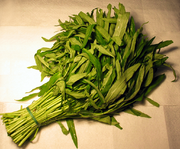 |
Phak bung | ผักบุ้ง | Morning-glory or water spinach Ipomoea aquatica Ipomoea aquatica is a semi-aquatic tropical plant grown as a leaf vegetable. It is known in English as Water Spinach, Water Morning Glory, Water Convolvulus, or by the more ambiguous names "Chinese spinach" and "swamp cabbage". It has many other names in other languages, such as "Phak bung" in Thai... |
The large variety (Phak bung chin) is mostly eaten stir-fried or in soup. The small variety (Phak bung na) is generally served raw with Som tam Som tam Som tam or som tum also known as tam bak hung is a spicy salad, the standard form of which is made from shredded unripened papaya. Som tam is similar to the Laotian dish tam mak hung and the Cambodian dish bok l'hong... or with Nam phrik Nam phrik Nam phrik , generally pronounced "Nam phik", is a generic term that may refer to any of the types of more or less thick spicy, often chili based, hot sauces typical of Thai cuisine. The main ingredients of Nam phrik are fresh or dry chilies, garlic, shallots, fish sauce, lime juice and/or some kind... . |
| Phak chi lom | ผักชีล้อม | Oenanthe javanica Oenanthe javanica Japanese parsley or Chinese celery is a plant of the water dropwort genus originating from East Asia.While many other species of water dropwort are extremely toxic, Oenanthe javanica is edible, and is cultivated in the People's Republic of China, India, Japan, Korea, Malaysia, Thailand , the... |
Eaten in soups, curries, stir-fries and also raw. This is one of the vegetables known as Phak chi lom, the other is Trachyspermum roxburghianum. | |
| Phak kat khao | ผักกาดขาว | Chinese cabbage Napa cabbage Napa cabbage , also known as celery cabbage, is a type of Chinese cabbage originating near the Beijing region of China, and is widely used in East Asian cuisine. In much of the world, this is the vegetable referred to as "Chinese cabbage"... |
Literally "white cabbage", it is often eaten in soups and stir-fried dishes but also raw, sliced very thin, with certain spicy noodle soups or raw with Nam phrik. | |
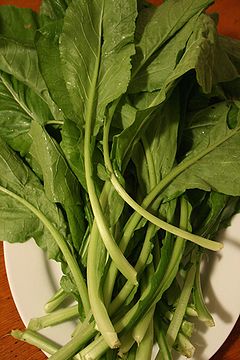 |
Phak kat khiao | ผักกาดเขียว | Mustard greens Brassica juncea Brassica juncea, also known as mustard greens, Indian mustard, Chinese mustard, and leaf mustard, is a species of mustard plant. Subvarieties include southern giant curled mustard, which resembles a headless cabbage such as kale, but with a distinct horseradish-mustard flavor... |
Literally "green cabbage", it is often eaten in soups and stir-fried dishes. |
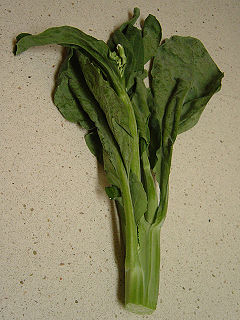 |
Phak khana | ผักคะน้า | Chinese broccoli or Kai-lan Kai-lan Kai-lan, also known as Chinese broccoli, is a leaf vegetable featuring thick, flat, glossy blue-green leaves with thick stems and a small number of tiny, almost vestigial flower heads similar to those of broccoli. Broccoli and kai-lan belong to the same species Brassica oleracea, but kai-lan is in... |
Mostly eaten stir-fried with oyster sauce Oyster sauce Oyster sauce describes a number of sauces made by cooking oysters. The most common in modern use is a viscous dark brown condiment made from sugar, salt and water thickened with cornstarch, flavoured with a little oyster essence or extract and some versions may be darkened with caramel, though high... . |
| Phak khayang | ผักแขยง | Limnophila aromatica Limnophila aromatica Limnophila aromatica is a tropical flowering plant in the plantain family, Plantaginaceae. It is native to Southeast Asia, where it flourishes in hot temperatures and grows most often in watery environments, particularly in flooded rice fields... |
Eaten raw with Nam phrik. Popular in Isan. | |
| Phak khom | ผักขม | Amaranthus spp. | Used in salads and in soups like Tom chap chai and Tom kha mu. Mostly hybrids are offered in the market. The red-leafed Amaranth is known as Phak khom bai daeng | |
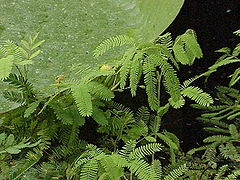 |
Phak krachet | ผักกระเฉด | Water mimosa | Usually eaten raw with Nam phrik. Popular in Isan. |
| Phak krathin | ผักกระถิน | Leucaena leucocephala | Tender pods or seeds are eaten raw with Nam phrik. | |
| Phak kwangtung | ผักกวางตุ้ง | Choy sum Choy sum Choy sum or choi sum literally means "vegetable heart" in Cantonese. While frequently used to describe edible stem of either of the two varieties of Chinese cabbage, usually the soft inner core of bok choy with the tougher outer leaves removed, the term can be applied to the "heart"–the soft core... |
Literally "Guangdong Guangdong Guangdong is a province on the South China Sea coast of the People's Republic of China. The province was previously often written with the alternative English name Kwangtung Province... greens", it is often eaten in soups and stir-fried dishes. |
|
| Phak waen | ผักแว่น | Marsilea crenata Marsilea crenata Marsilea crenata is a species of fern found in Southeast Asia. It is an aquatic plant looking like a four leaf clover. Leaves floating in deep water or erect in shallow water or on land... |
Eaten raw with Nam phrik. Popular in Isan. | |
| Phak wan | ผักหวาน | Melientha suavis | Used in soups, mainly the sour soup of the kaeng type. | |
| Riang | เหรียง | Tree bean | The young pods are edible. | |
| Sato khao | สะตอข้าว | Stink bean | The seeds of the Parkia speciosa Parkia speciosa Parkia speciosa is a plant of the genus Parkia in the family Fabaceae... (inside the pods) are usually eaten in stir fries. |
|
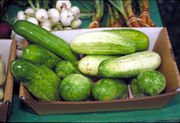 |
Taengkwa | แตงกวา | Cucumber Cucumber The cucumber is a widely cultivated plant in the gourd family Cucurbitaceae, which includes squash, and in the same genus as the muskmelon. The plant is a creeping vine which bears cylindrical edible fruit when ripe. There are three main varieties of cucumber: "slicing", "pickling", and... |
Typical Thai cucumbers are small. Eaten raw with Nam phrik or as a Som tam ingredient. |
| Tarapat rusi | ตาลปัตรฤๅษี | Limnocharis flava Limnocharis flava Limnocharis flava is a species of aquatic flowering plant which is native to Southeast Asia. It is a roughly 50 cm tall plant growing in clumps.... |
Eaten in soups, curries and stir-fries. Popular in Isan. | |
| Thua fak yao | ถั่วฝักยาว | Yardlong bean Yardlong bean Vigna unguiculata subsp. sesquipedalis, the yardlong bean, is also known as bora, the long-podded cowpea, asparagus bean, snake bean, or Chinese long bean... s |
A very versatile bean, it is used in curries and stir-fried dishes, but also served raw in Som tam Som tam Som tam or som tum also known as tam bak hung is a spicy salad, the standard form of which is made from shredded unripened papaya. Som tam is similar to the Laotian dish tam mak hung and the Cambodian dish bok l'hong... salad or together with a Nam phrik Nam phrik Nam phrik , generally pronounced "Nam phik", is a generic term that may refer to any of the types of more or less thick spicy, often chili based, hot sauces typical of Thai cuisine. The main ingredients of Nam phrik are fresh or dry chilies, garlic, shallots, fish sauce, lime juice and/or some kind... (chilli dip). |
|
| Thua ngok | ถั่วงอก | Bean sprouts | It is often eaten in soups and stir-fried dishes. Thais tend to eat bean sprouts raw to semi-raw, for instance in Phat Thai noodles where it is either sprinkled on top of the finished dish raw or added in to the pan for one quick stir before serving | |
| Thua phu | ถั่วพู | Winged bean Winged bean The Winged bean , also known as the Goa bean and Asparagus Pea and Winged Pea, is a tropical legume plant native to New Guinea. It grows abundantly in hot, humid equatorial countries, from the Philippines and Indonesia to India, Burma, Thailand and Sri Lanka. It does well in humid tropics with high... |
Often eaten raw with Nam phrik. | |
| Thua rae | ถั่วแระ | Soybean Soybean The soybean or soya bean is a species of legume native to East Asia, widely grown for its edible bean which has numerous uses... |
Pods are boiled and seeds are eaten as a snack with salt. | |
Roots
| Image | Thai name Royal Thai General System of Transcription The Royal Thai General System of Transcription is the official system for rendering Thai language words in the Latin alphabet, published by the Royal Institute of Thailand... |
Thai script | English name | Description and use |
|---|---|---|---|---|
| Man kaeo | มันแกว | Jicama Jícama Pachyrhizus erosus, commonly known as Jícama , Yam, and Mexican Turnip, is the name of a native Mexican vine, although the name most commonly refers to the plant's edible tuberous root. Jícama is one species in the genus Pachyrhizus. Plants in this genus are commonly referred to as yam bean,... |
This tuberous root is mostly eaten raw with sugar, as if it was a fruit. | |
| Man sampalang | มันสำปะหลัง | Cassava Cassava Cassava , also called yuca or manioc, a woody shrub of the Euphorbiaceae native to South America, is extensively cultivated as an annual crop in tropical and subtropical regions for its edible starchy tuberous root, a major source of carbohydrates... |
A popular traditional cassava-based dish is Chueam , a candied starchy dessert. The tubers are also used for making tapioca Tapioca Tapioca is a starch extracted Manihot esculenta. This species, native to the Amazon, Brazil, Colombia, Venezuela, Cuba, Puerto Rico, Haiti, the Dominican Republic, Honduras, and most of the West Indies, is now cultivated worldwide and has many names, including cassava, manioc, aipim,... pearls used in desserts and drinks. |
|
 |
Man thet | มันเทศ | Sweet potato Sweet potato The sweet potato is a dicotyledonous plant that belongs to the family Convolvulaceae. Its large, starchy, sweet-tasting, tuberous roots are an important root vegetable. The young leaves and shoots are sometimes eaten as greens. Of the approximately 50 genera and more than 1,000 species of... |
Man thet (literally meaning "foreign tuber") is popularly also known as man daeng ; boiled pieces are eaten as a snack or used as an ingredient for desserts. |
| Pheuak | เผือก | Taro Taro Taro is a common name for the corms and tubers of several plants in the family Araceae . Of these, Colocasia esculenta is the most widely cultivated, and is the subject of this article. More specifically, this article describes the 'dasheen' form of taro; another variety is called eddoe.Taro is... |
Usually boiled pieces are an ingredient of a variety of desserts. Slices of deep fried taro are also popular as a snack. | |
Flowers and tree leaves
| Image | Thai name Royal Thai General System of Transcription The Royal Thai General System of Transcription is the official system for rendering Thai language words in the Latin alphabet, published by the Royal Institute of Thailand... |
Thai script | English name | Description and use |
|---|---|---|---|---|
| Bai makok | ใบมะกอก | Spondias mombin Spondias mombin Spondias mombin is a tree, a species of flowering plant in the family Anacardiaceae. It is native to the tropical Americas, including the West Indies. The tree has been naturalized in parts of Africa, India, Sri Lanka and Indonesia. It is rarely cultivated.The mature fruit has a leathery skin and a... |
Bai makok is the leaf of the Spondias mombin, a relative of the cashew. The young leaves are served raw with certain types of Nam phrik Nam phrik Nam phrik , generally pronounced "Nam phik", is a generic term that may refer to any of the types of more or less thick spicy, often chili based, hot sauces typical of Thai cuisine. The main ingredients of Nam phrik are fresh or dry chilies, garlic, shallots, fish sauce, lime juice and/or some kind... (Thai chilli pastes). The taste is sour and slightly bitter. The fruit of this tree are also eaten. |
|
| Cha-om | ชะอม | Acacia pennata Acacia pennata Acacia pennata is a species of acacia which is native to South and Southeast Asia. It is a shrub or small tropical tree which grows up to 5 metres in height. Its leaves are bipinnate with linear-oblong and glabrous pinnules. Its yellowish flowers are terminal panicles with globose heads... |
Young feathery leaves of the Acacia pennata tree which are used in omelettes, soups and curries. In Northern Thai cuisine they are also eaten raw as for instance with Tam mamuang, a green mango salad. | |
_fruits_in_kolkata_w_img_8547.jpg) |
Chiknam or Kradon | จิกน้ำ or กระโดน | Barringtonia acutangula Barringtonia acutangula Barringtonia acutangula is a species of Barringtonia native to coastal wetlands in southern Asia and northern Australasia, from Afghanistan east to the Philippines and Queensland.-Medicinal Uses:Antitumor Antibiotic... |
Shoots, young leaves and flowers of the tree are eaten raw with Nam phrik. Popular in Isan. |
 |
Dok anchan | ดอกอัญชัน | Clitoria ternatea Clitoria ternatea Clitoria ternatea is a plant species belonging to the Fabaceae family.- Distribution :This plant is native to tropical equatorial Asia, but has been introduced to Africa, Australia and America.... |
Can be eaten raw or fried, but mostly it is used to make a blue food colouring to colour rice or sweets, like Khanom dok anchan. |
| Dok khae | ดอกแค | Sesbania grandiflora Sesbania grandiflora Sesbania grandiflora or hummingbird tree/scarlet wisteria is a small tree in the genus Sesbania.-Description:... |
The flowers of the Sesbania grandiflora are often eaten steamed with Nam phrik or used in certain curries and salads. | |
| Dok salit | ดอกสลิด | Telosma cordata Telosma cordata Telosma cordata Telosma cordata Telosma cordata (Tonkin jasmine, pakalana vine, Tonkinese creeper, Chinese violet, (Vietnamese Thiên lý), is a species of flowering plant native to China. It is cultivated elsewhere and may occur wild as an introduced species.... |
Mostly either boiled and eaten with Nam phrik or stir-fried in Phat dok salit. | |
| Dok sano | ดอกโสน | Sesbania bispinosa Sesbania bispinosa The legume Sesbania bispinosa, also known as Sesbania aculeata Pers., is a small tree in the genus Sesbania.The flower is the provincial flower of Phra Nakhon Si Ayutthaya Province, Thailand.-Names:... |
These small yellow flowers are eaten stir-fried, in omelette or in sweets such as in Khanom dok sano. | |
| Huapli | หัวปลี | Banana Banana Banana is the common name for herbaceous plants of the genus Musa and for the fruit they produce. Bananas come in a variety of sizes and colors when ripe, including yellow, purple, and red.... flower |
Banana flowers can be eaten raw, e.g. Yam hua pli (a spicy salad with thinly sliced banana flowers), or steamed with a Nam phrik (chilli dip). It can also feature in Som tam Som tam Som tam or som tum also known as tam bak hung is a spicy salad, the standard form of which is made from shredded unripened papaya. Som tam is similar to the Laotian dish tam mak hung and the Cambodian dish bok l'hong... , in soups or deep-fried, as in Thot man huapli. The taste of the steamed flowers is somewhat similar to that of artichokes. |
|
| Pheka | เพกา | Oroxylum indicum Oroxylum indicum Oroxylum indicum is a species of flowering plant belonging to the family Bignoniaceae.-Names:* Bignonia indica, L., Species Plantarum 2: 625. 1753.* Spathodea indica, L., Pers. Synopsis Plantarum 2: 173. 1807.... |
Leaves and young pods are eaten raw. The large mature pods are grilled and the inside is scraped and eaten along with Lap Larb Larb is a type of Laotian and Isan meat salad that is regarded as the national dish of Laos. Larb is a creation of the Lao people, with 20 million living in the Isan region of Thailand, and 4.5 million in Laos. Larb originated in Laos and is one of the most famous dishes from Laos... . |
|
| Sadao | สะเดา | Neem Neem Azadirachta indica is a tree in the mahogany family Meliaceae. It is one of two species in the genus Azadirachta, and is native to India growing in tropical and semi-tropical regions. Its fruits and seeds are the source of neem oil... tree |
The leaves and flowers of the neem tree (Azadirachta indica) are eaten blanched, often with Nam phrik Nam phrik Nam phrik , generally pronounced "Nam phik", is a generic term that may refer to any of the types of more or less thick spicy, often chili based, hot sauces typical of Thai cuisine. The main ingredients of Nam phrik are fresh or dry chilies, garlic, shallots, fish sauce, lime juice and/or some kind... . |
|
Edible fungi and algae
| Image | Thai name Royal Thai General System of Transcription The Royal Thai General System of Transcription is the official system for rendering Thai language words in the Latin alphabet, published by the Royal Institute of Thailand... |
Thai script | English name | Description and use |
|---|---|---|---|---|
| Het fang | เห็ดฟาง | Straw mushroom | ||
| Het hu nu | เห็ดหูหนู | Cloud ear fungus Cloud ear fungus Cloud ear fungus is an edible jelly fungus. It is gray-brown in color and often used in Asian cooking.-Etymology:... |
||
 |
Het hu nu khao | เห็ดหูหนูขาว | White jelly fungus | |
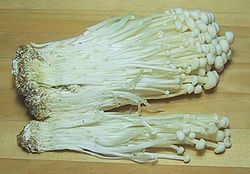 |
Het khem thong | เห็ดเข็มทอง | Golden needle mushroom Enokitake Enokitake , also Enokidake or Enoki are long, thin white mushrooms used in East Asian cuisine . These mushrooms are cultivars of Flammulina velutipes also called golden needle mushroom... |
|
Fruits and nuts
| Image | Thai name Royal Thai General System of Transcription The Royal Thai General System of Transcription is the official system for rendering Thai language words in the Latin alphabet, published by the Royal Institute of Thailand... |
Thai script | English name | Description and use |
|---|---|---|---|---|
| Chomphu | ชมพู่ | Rose apple Syzygium samarangense Syzygium samarangense is a plant species in the Myrtaceae, native to India, Indonesia, Malaysia, Philippines, Samoa, Sri Lanka and Thailand, and widely cultivated in the tropics... |
||
| Farang | ฝรั่ง | Guava Psidium guajava The apple guava or common guava is an evergreen shrub or small tree native to Mexico, the Caribbean, and Central and South America... |
||
| Kaeo mangkon | แก้วมังกร | Dragonfruit | There are two varieties in the market, one is white inside, the other dark purple. | |
| Khanun | ขนุน | Jackfruit Jackfruit The jackfruit is a species of tree in the Artocarpus genus of the mulberry family . It is native to parts of Southern and Southeast Asia. It is the national fruit of Bangladesh, . The jackfruit tree is believed to be indigenous to the southwestern rain forests of India... |
All parts of this large fruit are edible. The flesh around the seeds is preferred in Thailand, usually eaten raw or fried. Whole boiled unripe khanun is used in a Northern Thai salad called tam khanun. | |
| Kluai | กล้วย | Banana Banana Banana is the common name for herbaceous plants of the genus Musa and for the fruit they produce. Bananas come in a variety of sizes and colors when ripe, including yellow, purple, and red.... |
Traditionally eaten mainly while green and unripe, steamed, grilled or fried. Also eaten ripe as a fruit. | |
| Krachap | กระจับ | Water caltrop Water caltrop The water caltrop, water chestnut, buffalo nut, bat nut, devil pod or Singhara or Pani-fol is either of two species of the genus Trapa: Trapa natans and Trapa bicornis... |
Also known as water chestnut. It should be eaten boiled because it can be a carrier of fasciolopsiasis Fasciolopsiasis Fasciolopsiasis results from an infection by the trematode Fasciolopsis buski, the largest intestinal fluke of humans .-Infection cycle:... . |
|
| Krathon | กระท้อน | Santol Santol (fruit) The santol is a tropical fruit grown in Southeast Asia.-Origin and distribution:The santol is believed native to former Indochina and Peninsular Malaysia, and to have been introduced into India, Borneo, Indonesia, the Moluccas, Mauritius, and the Philippines where it has become naturalized... |
Used as a main ingredient in Tam krathon, a variant of Som tam. | |
| Lamut | ละมุด | Sapodilla | ||
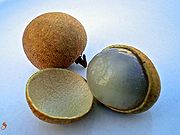 |
Lamyai | ลำไย | Longan Longan Dimocarpus longan, commonly known as the longan, is a tropical tree native to South and Southeast Asia, in the Indomalaya ecozone known for its edible fruit.-Vernacular names:The fruit is known as longan or longyan in English... |
|
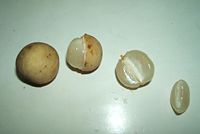 |
Longkong | ลองกอง | Duku Lansium domesticum Lansium domesticum, also known as langsat or lanzones, is a fruit from the family Meliaceae. The plant, which originates from western Southeast Asia. It is the provincial flower for the Indonesian province of South Sumatra.-Names:... |
|
| Makham | มะขาม | Tamarind Tamarind Tamarind is a tree in the family Fabaceae. The genus Tamarindus is monotypic .-Origin:... |
The pulp is used to give a pleasant sour taste to some soups, curries and Pad Thai. Also used to make sweets and refreshing drinks. | |
| Makham thet | มะขามเทศ | Madras thorn Pithecellobium dulce Pithecellobium dulce is a species of flowering plant in the pea family, Fabaceae, that is native to Mexico, Central America, and northern South America. It is introduced and extensively naturalised in the Caribbean, Florida, Guam and Southeast Asia. It is considered an invasive species in Hawaii.It... |
Less strongly flavoured than tamarind, which it resembles. Eaten as a fruit. | |
| Makok | มะกอก | Spondias mombin Spondias mombin Spondias mombin is a tree, a species of flowering plant in the family Anacardiaceae. It is native to the tropical Americas, including the West Indies. The tree has been naturalized in parts of Africa, India, Sri Lanka and Indonesia. It is rarely cultivated.The mature fruit has a leathery skin and a... |
Used as a secondary ingredient in Som tam. | |
| Malako | มะละกอ | Papaya Papaya The papaya , papaw, or pawpaw is the fruit of the plant Carica papaya, the sole species in the genus Carica of the plant family Caricaceae... |
Traditionally eaten mainly while green and unripe as a main ingredient in Som tam Som tam Som tam or som tum also known as tam bak hung is a spicy salad, the standard form of which is made from shredded unripened papaya. Som tam is similar to the Laotian dish tam mak hung and the Cambodian dish bok l'hong... . |
|
| Mamuang | มะม่วง | Mango Mango The mango is a fleshy stone fruit belonging to the genus Mangifera, consisting of numerous tropical fruiting trees in the flowering plant family Anacardiaceae. The mango is native to India from where it spread all over the world. It is also the most cultivated fruit of the tropical world. While... |
Often eaten green and sour as an ingredient in salads and sauces, but also as a ripe fruit. | |
| Manao | มะนาว | Lime Lime (fruit) Lime is a term referring to a number of different citrus fruits, both species and hybrids, which are typically round, green to yellow in color, 3–6 cm in diameter, and containing sour and acidic pulp. Limes are a good source of vitamin C. Limes are often used to accent the flavors of foods and... |
Indispensable to Thai cuisine, it serves as the main ingredient for adding acidity to Thai dishes such as with Tom yum Tom yum Tom yum or tom yam is the name for a spicy clear soup typical in Laos and Thailand. Tom yum is widely served in neighboring countries such as Malaysia, Singapore, and Indonesia, and has been popularized around the world... and Larb Larb Larb is a type of Laotian and Isan meat salad that is regarded as the national dish of Laos. Larb is a creation of the Lao people, with 20 million living in the Isan region of Thailand, and 4.5 million in Laos. Larb originated in Laos and is one of the most famous dishes from Laos... . It can also be eaten chopped together with the peel in dishes such as Miang kham. Mixed with sugar and water it serves as a refreshing drink. |
|
 |
Mangkhut | มังคุด | Mangosteen Mangosteen The purple mangosteen , colloquially known simply as mangosteen, is a tropical evergreen tree believed to have originated in the Sunda Islands and the Moluccas of Indonesia. The tree grows from 7 to 25 m tall... |
|
| Maphrao | มะพร้าว | Coconut Coconut The coconut palm, Cocos nucifera, is a member of the family Arecaceae . It is the only accepted species in the genus Cocos. The term coconut can refer to the entire coconut palm, the seed, or the fruit, which is not a botanical nut. The spelling cocoanut is an old-fashioned form of the word... |
The young nut is popular as a refreshing drink. Coconut milk Coconut milk Coconut milk is the water that comes from the grated meat of a coconut. The colour and rich taste of the milk can be attributed to the high oil content. In many parts of the world, the term coconut milk is also used to refer to coconut water, the naturally occurring liquid found inside the hollow... is extracted out of the grated flesh of the ripe nuts and is used in a number of dishes and curries, especially in Southern Thailand Southern Thailand Southern Thailand is a distinct region of Thailand, connected with the Central region by the narrow Kra Isthmus.-Geography:Southern Thailand is located on the Malay Peninsula, with an area around 70,713 km², bounded to the north by Kra Isthmus as the narrowest part of the peninsula. The... . |
|
| Maprang | มะปราง | Bouea macrophylla Bouea macrophylla Bouea macrophylla is a tropical fruit tree native to Southeast Asia. The tree belongs to the family Anacardiaceae, and is related to the mango.-Description:The evergreen tree grows to height of 25 meters... |
The seed is also edible. | |
 |
Mayom | มะยม | Phyllanthus acidus | Can be used as a secondary ingredient in Som tam. |
| Ngo | เงาะ | Rambutan Rambutan The rambutan is a medium-sized tropical tree in the family Sapindaceae, and the fruit of this tree. It is native to Vietnam, Indonesia, the Philippines, Sri Lanka, Malaysia, and elsewhere in Southeast Asia, although its precise natural distribution is unknown. It is closely related to several... |
||
| Noina | น้อยหน่า | Sugar-apple Sugar-apple Annona squamosa is a species of Annona native to the tropical Americas and widely grown in Colombia, El Salvador, India, Pakistan and the Philippines... |
||
| Phutsa | พุทรา | Jujube Jujube Ziziphus zizyphus , commonly called jujube , red date, Chinese date, Korean date, or Indian date is a species of Ziziphus in the buckthorn family Rhamnaceae, used primarily as a fruiting shade tree.-Distribution:Its precise natural distribution is uncertain due to extensive cultivation,... |
||
| Sala | สละ | Snake fruit Salak Salak is a species of palm tree native to Indonesia. It is a very short-stemmed palm, with leaves up to long; each leaf has a 2-metre long petiole with spines up to long, and numerous leaflets.... |
The taste of the fruit is somewhat musty, and somewhere in between dried bananas, jackfruit Jackfruit The jackfruit is a species of tree in the Artocarpus genus of the mulberry family . It is native to parts of Southern and Southeast Asia. It is the national fruit of Bangladesh, . The jackfruit tree is believed to be indigenous to the southwestern rain forests of India... , and preserved dates. Some people mistakenly name sala as rakam , which is another variety of snake fruit with a slightly more watery taste and a more spherical appearance. |
|
 |
Saowarot | เสาวรส | Passionfruit Passiflora edulis Passiflora edulis is a vine species of passion flower that is native to Paraguay, Brazil and northern Argentina . Its common names include passion fruit and passionfruit... |
Used to make refreshing drinks. |
| Saparot | สับปะรด | Pineapple Pineapple Pineapple is the common name for a tropical plant and its edible fruit, which is actually a multiple fruit consisting of coalesced berries. It was given the name pineapple due to its resemblance to a pine cone. The pineapple is by far the most economically important plant in the Bromeliaceae... |
It can also be used in cooking. | |
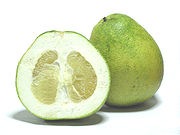 |
Som-o | ส้มโอ | Pomelo Pomelo The pomelo is a citrus fruit native to Southeast Asia. It is usually pale green to yellow when ripe, with sweet white flesh and very thick albedo . It is the largest citrus fruit, 15–25 cm in diameter, and usually weighing 1–2 kg... |
In Thailand, pomelo is often eaten dipped in to a spicy mix of dried chilli flakes, sugar and salt. It can also be used in spicy Thai salads such as Yam som-o . |
| Talingpling | ตะลิงปลิง | Bilimbi Bilimbi Averrhoa bilimbi is a fruit-bearing tree of the genus Averrhoa, family Oxalidaceae. It is a close relative of the carambola.-Nomenclature:... |
Very sour. Can be used instead of lime or tamarind in soups such as in Tom yam. Also eaten raw with sugar and chilli mixture. | |
| Thurian | ทุเรียน | Durian Durian The durian is the fruit of several tree species belonging to the genus Durio and the Malvaceae family . Widely known and revered in southeast Asia as the "king of fruits", the durian is distinctive for its large size, unique odour, and formidable thorn-covered husk... |
One of the most popular fruits in Thailand. | |
Staple foods and other starches
| Image | Thai name Royal Thai General System of Transcription The Royal Thai General System of Transcription is the official system for rendering Thai language words in the Latin alphabet, published by the Royal Institute of Thailand... |
Thai script | English name | Description and use |
|---|---|---|---|---|
| Bami | บะหมี่ | Egg noodles | Similar to the Chinese mee pok Mee pok Mee pok is a type of Chinese noodle characterized by its flat and yellow appearance, varying in thickness and width. The dish is of Teochew origin and is commonly served in a number of countries such as Chaoshan , Singapore, Malaysia and Thailand... and lamian Lamian Lamian is a type of hand-made or hand-pulled Chinese noodle. It is also the name of the dishes that use these noodles.-Etymology and preparation:... , it was not common in Thailand until in recent years as it is made from wheat Wheat Wheat is a cereal grain, originally from the Levant region of the Near East, but now cultivated worldwide. In 2007 world production of wheat was 607 million tons, making it the third most-produced cereal after maize and rice... which had to be imported. It is used stir-fried, deep-fried (mi krop) and in noodle soups. |
|
| Khanom Chin | ขนมจีน | Thai rice vermicelli Rice vermicelli Rice vermicelli are thin noodles made from rice and are a form of rice noodles. They are sometimes referred to as rice noodles or rice sticks, but they should not be confused with cellophane noodles, which is another type of vermicelli.... |
Fresh rice vermicelli Rice vermicelli Rice vermicelli are thin noodles made from rice and are a form of rice noodles. They are sometimes referred to as rice noodles or rice sticks, but they should not be confused with cellophane noodles, which is another type of vermicelli.... made from fermented rice. It is commonly seen as a noodle to go with certain spicy soups and curries, but it is also popular with som tam Som tam Som tam or som tum also known as tam bak hung is a spicy salad, the standard form of which is made from shredded unripened papaya. Som tam is similar to the Laotian dish tam mak hung and the Cambodian dish bok l'hong... and other Thai salads. Mon (มอญ) origin. |
|
| Khao | ข้าว | Rice Rice Rice is the seed of the monocot plants Oryza sativa or Oryza glaberrima . As a cereal grain, it is the most important staple food for a large part of the world's human population, especially in East Asia, Southeast Asia, South Asia, the Middle East, and the West Indies... |
The ultimate staple food for Thai people, so much that it can also mean "food" in general as in kin khao: "to eat (kin) rice" means the same as "to eat food". | |
| Khao hom mali | ข้าวหอมมะลิ | Jasmine rice Jasmine rice Jasmine rice , sometimes known as Thai fragrant rice, is a long-grain variety of rice that has a nutty aroma and a subtle pandan-like flavor caused by 2-acetyl-1-pyrroline.Jasmine rice is originally from Thailand... or Thai fragrant rice |
This long-grained variety of rice, with its nutty aroma and a subtle pandan Pandanus amaryllifolius Pandanus amaryllifolius is a tropical plant in the screwpine genus which is known commonly as pandan and is used widely in Southeast Asian cooking as a flavoring. The plant is rare in the wild but is widely cultivated. It is an upright green plant with fan-shaped sprays of long, narrow, bladelike... -like flavour, originates from Thailand and now forms the bulk of Thailand's rice crop. |
|
| Khao niao | ข้าวเหนียว | Glutinous rice Glutinous rice Glutinous rice is a type of short-grained Asian rice that is especially sticky when cooked. It is called glutinous Glutinous rice (Oryza sativa var. glutinosa or Oryza glutinosa; also called sticky rice, sweet rice, waxy rice, botan rice, biroin chal, mochi rice, and pearl rice, and pulut) is a... or sticky rice |
The main type of rice traditionally eaten in the Northeast and North of Thailand. It is often served in a special bamboo container called a kratip khao | |
| Khao niao dam | ข้าวเหนียวดำ | Black glutinous rice Glutinous rice Glutinous rice is a type of short-grained Asian rice that is especially sticky when cooked. It is called glutinous Glutinous rice (Oryza sativa var. glutinosa or Oryza glutinosa; also called sticky rice, sweet rice, waxy rice, botan rice, biroin chal, mochi rice, and pearl rice, and pulut) is a... |
With a nutty taste, it can be mixed together with steamed white rice and eaten with savoury dishes or served sweetened together with coconut milk. | |
| Kuai tiao | ก๋วยเตี๋ยว | Rice noodles | The generic Thai word for rice noodles Rice noodles Rice noodles are noodles that are made from rice. Their principal ingredients are rice flour and water. However, sometimes other ingredients such as tapioca or corn starch are also added in order to improve the transparency or increase the gelatinous and chewy texture of the noodles.Rice noodles... . The name comes from the Teochew dialect of Chinese, where the word kuai tiao literally means "cake strips". In Chinese it only designates the wide variety which in Thai is called kuai tiao sen yai (see shahe fen Shahe fen Shahe fen or he fen is a type of wide Chinese noodle made from rice.-Names:While shahe fen and he fen are transliterations based on Mandarin, there are numerous other transliterations based on Cantonese, which include ho fen, hofen, ho-fen, ho fun, ho-fun, hofoen , hor fun, hor... ). |
|
| Paeng khao chao | แป้งข้าวเจ้า | Rice flour Rice flour Rice flour is a form of flour made from finely milled rice. It is distinct from rice starch, which is usually produced by steeping rice in lye.... |
Used mainly in desserts and as a thickening agent | |
| Paeng man sampalang | แป้งมันสำปะหลัง | Tapioca Tapioca Tapioca is a starch extracted Manihot esculenta. This species, native to the Amazon, Brazil, Colombia, Venezuela, Cuba, Puerto Rico, Haiti, the Dominican Republic, Honduras, and most of the West Indies, is now cultivated worldwide and has many names, including cassava, manioc, aipim,... flour |
Used mainly in desserts and as a thickening agent | |
| Sen lek | เส้นเล็ก | Narrow rice noodle | Narrow, flat rice noodles; used in such dishes as Phat Thai Pad Thai Pad Thai or Phat Thai is a dish of stir-fried rice noodles with eggs, fish sauce , tamarind juice, red chilli pepper, plus any combination of bean sprouts, shrimp, chicken, or tofu, garnished with crushed peanuts, coriander and lime, the juice of which can be added along with Thai condiments Pad... and in noodle soups. Its full name would be kuai tiao sen lek. |
|
| Sen mi | เส้นหมี่ | Rice vermicelli (thin) | Similar to the Chinese rice vermicelli Rice vermicelli Rice vermicelli are thin noodles made from rice and are a form of rice noodles. They are sometimes referred to as rice noodles or rice sticks, but they should not be confused with cellophane noodles, which is another type of vermicelli.... ; used in noodle soups. Its full name would be kuai tiao sen mi. |
|
| Sen yai | เส้นใหญ่ | Wide rice noodle | Wide, flat rice noodles, similar to the Chinese shahe fen Shahe fen Shahe fen or he fen is a type of wide Chinese noodle made from rice.-Names:While shahe fen and he fen are transliterations based on Mandarin, there are numerous other transliterations based on Cantonese, which include ho fen, hofen, ho-fen, ho fun, ho-fun, hofoen , hor fun, hor... ; used in dishes such as kuai tiao phat si-io and in noodle soups. Its full name would be kuai tiao sen yai. |
|
| Wunsen | วุ้นเส้น | Cellophane noodles Cellophane noodles Cellophane noodles are a type of transparent noodle made from starch , and water.They are generally sold in dried form, boiled to reconstitute, then used in soups, stir fried dishes,... or glass noodles |
Extremely thin noodles made from mung bean Mung bean The mung bean is the seed of Vigna radiata. It is native to the Indian subcontinent.-Description:They are small, ovoid in shape, and green in color... flour which turn transparent when moist. It can be used in salads and soups, or stir-fried. |
|
Meat and poultry
| Image | Thai name Royal Thai General System of Transcription The Royal Thai General System of Transcription is the official system for rendering Thai language words in the Latin alphabet, published by the Royal Institute of Thailand... |
Thai script | English name | Description and use |
|---|---|---|---|---|
Fish and seafood
| Image | Thai name Royal Thai General System of Transcription The Royal Thai General System of Transcription is the official system for rendering Thai language words in the Latin alphabet, published by the Royal Institute of Thailand... |
Thai script | English name | Description and use |
|---|---|---|---|---|
| Hoi kraeng | หอยแครง | Blood cockle Blood cockle Anadara granosa is a species of ark clam known as the blood cockle due to the red haemoglobin liquid inside. It is found throughout the Indo-Pacific region from eastern Africa to Australia to Polynesia to Japan. It lives mainly in the intertidal zone at one to two metres water depth, burrowed down... |
Eaten raw or blanched with a nam chim (spicy dipping sauce), or used blanched in a Thai salad. | |
| Hoi lai | หอยลาย | Undulated Venus | This clam is highly appreciated in Thai cuisine; usually steamed, stir-fried or added to soups. | |
| Hoi malaeng phu | หอยแมลงภู่ | Asian green mussel Perna viridis The Asian green mussel , also known as the Philippine green mussel, is an economically important mussel, a bivalve belonging to the family Mytilidae. It is harvested for food but is also known to harbor toxins and cause damage to submerged structures such as drainage pipes... |
Usually steamed or also boiled in soups. | |
| Kung haeng | กุ้งแห้ง | Dried shrimp Dried shrimp Dried shrimp are shrimp that have been sun dried and shrunk to a thumbnail size. They are used in many Asian cuisines, imparting a unique umami taste. A handful of shrimp is generally used for dishes... |
Salted and sun-dried, dried shrimp feature in many dishes and chilli pastes. They are often soaked in water before use. | |
| Kung kamkram | กุ้งก้ามกราม | Giant river prawn | Mostly bred in local fish farms. Boiled in Tom yam, grilled or fried. | |
| Pla chon | ปลาช่อน | Channa striata Channa striata The snakehead murrel, Channa striata, is a species of snakehead fish. It is also known as the common snakehead, chevron snakehead, striped snakehead, haloan, aruan, haruan and dalag... |
Usually eaten barbecued or steamed. It is the main fish used in the preparation of Pla ra Pla ra Pla ra is fermented fish sauce, popular in Northeastern Thai cuisine.It is made by pickling several varieties of fish, mainly Snakehead Murrel . The fish is cleaned and cut into pieces, after which it is mixed with salt and rice bran... sauce. |
|
| Pla duk | ปลาดุก | Clarias batrachus Clarias Clarias is a genus of catfishes of the family Clariidae, the airbreathing catfishes. The name is derived from the Greek chlaros, which means lively, in reference to the ability of the fish to live for a long time out of water.... |
Usually eaten barbecued, but also flaked and deep-fried in Yam pladuk fu. | |
 |
Pla kraho | ปลากระโห้ | Siamese giant carp Giant Barb The giant barb or Siamese giant carp, Catlocarpio siamensis , is the largest species of carp in the world. These migratory fish are found only in the Mae Klong, Mekong and Chao Phraya river basins... |
Highly valued in traditional Thai cuisine. Like most of the Thai food species that are not bred in fish farms, overfishing has caused a serious decline in its numbers. |
 |
Pla krai | ปลากราย | Chitala chitala Chitala chitala Chitala chitala or clown knifefish is a fish of the genus Chitala found in India and other countries in Southeast Asia. Main foods are smaller fishes and fish pellets . They have been introduced to some areas of the United States. As an aquarium fish, they are popular in the United States and... |
Usually eaten deep-fried with Nam chim (spicy dipping sauce) and leafy greens. It is the main fish used in Thot man pla (Thai fish cakes). |
| Pla kraphong | ปลากระพง | Barramundi Barramundi The Barramundi , also known as Asian Seabass, is a species of catadromous fish in family Latidae of order Perciformes. The native species is widely distributed in the Indo-West Pacific region from the Persian Gulf, through Southeast Asia to Papua New Guinea and Northern Australia. Known in Thai... |
Prepared in a variety of ways, boiled or fried, especially good boiled with lemon. Presently most Pla krapong Lutjanidae Snappers are a family of perciform fish, mainly marine but with some members inhabiting estuaries, feeding in freshwater. Some are important food fish. One of the best known is the red snapper.... in Thailand are Barramundi from local fish farms. |
|
| Pla nin | ปลานิล | Oreochromis niloticus Oreochromis niloticus The Nile Tilapia, Oreochromis niloticus is a relatively large cichlid fish, which is native to Africa from Egypt south to East and Central Africa, and as far west as Gambia. It is also native to Israel, and numerous introduced populations exist outside its natural range.It is also commercially... |
Barbecued, boiled or fried. Especially popular rubbed with salt and barbecued. Nile Tilapia in Thailand are bred in local fish farms. | |
| Pla salit | ปลาสลิด | Snakeskin gourami Snakeskin gourami Trichopodus pectoralis, also known as snakeskin gourami and Siamese gourami is a species of gourami that is important both as a food fish and as an aquarium fish.-Physical characteristics:... |
Usually fried or barbecued. | |
| Pla sio ao | ปลาซิวอ้าว | Luciosoma bleekeri | One of the most abundant of the different types of minnow-sized fishes (Pla sio) used in Thai cuisine. These tiny fish are often eaten salted and dried, fried, but also raw in Isan cuisine. | |
| Pla taphian | ปลาตะเพียน | Silver Barb Java Barb The Java Barb, more commonly known as Silver Barb in aquaculture, , Pla taphian; Lao Pa keng; , is a species of ray-finned fish in the genus Barbonymus.-Aquaculture:... |
Bred in local fish farms. Usually either pickled as Pla som (ปลาส้ม) or boiled in Tom yam. | |
| Pla thapthim | ปลาทับทิม | Red hybrid of Oreochromis niloticus Oreochromis niloticus The Nile Tilapia, Oreochromis niloticus is a relatively large cichlid fish, which is native to Africa from Egypt south to East and Central Africa, and as far west as Gambia. It is also native to Israel, and numerous introduced populations exist outside its natural range.It is also commercially... |
The red-hybrid Oreochromis niloticus is known as Pla Thapthim "pomegranate fish". They are bred in local fish farms. | |
| Pla thu | ปลาทู | Processed mackerel | Steamed and salted Shortbodied or Indian mackerel Indian mackerel The Indian mackerel is a species ofmackerel in the scombrid family of orderPerciformes. It is commonlyfound in the Indian and WestPacific oceans, and their surrounding seas... . Usually eaten with Nam phrik kapi (a chili and shrimp paste Shrimp paste Shrimp paste or shrimp sauce, is a common ingredient used in Southeast Asian and Southern Chinese cuisine. It is known as terasi in Indonesian, ngapi in Burmese, kapi in Thai, Khmer and Lao language, belacan in Malay, mắm ruốc, mắm tép and mắm tôm in... dip) and leafy greens and vegetables. |
|
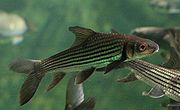 |
Pla yisok | ปลายี่สก | Jullien's Golden Carp Jullien's Golden Carp The Jullien's Golden Carp, Seven-striped Barb, Isok Barb, Barbeau De Jullien, or Carpilla Ikan Temoleh is a species of freshwater ray-finned fish in the Cyprinidae family.... |
One of the most valued fishes in traditional Thai cuisine, nowadays it has become rare and expensive due to overfishing. |
| Pu ma | ปูม้า | Portunus pelagicus Portunus pelagicus Portunus pelagicus, also known as the flower crab, blue crab, blue swimmer crab, blue manna crab or sand crab, is a large crab found in the intertidal estuaries of the Indian and Pacific Oceans and the Middle-Eastern coast of the Mediterranean Sea. The name "flower crab" is used in east Asian... |
Highly appreciated relatively large crab, featuring in standard dishes as Pu ma phat ton hom , among others. | |
| Pu na | ปูนา | Rice field crabs Parathelphusidae Parathelphusidae is a family of freshwater crabs mainly in Southeast Asia. Their closest living relatives are the Gecarcinucidae.The Parathelphusidae inhabit rivers, lakes and rice paddies. Some species, for example from the genus Somanniathelphusa, are locally important as food, particularly in... |
When pickled they are most often called pu dong (pickled crab; ), or less often pu khem (salted crab; ), and frequently used in papaya salad Som tam Som tam or som tum also known as tam bak hung is a spicy salad, the standard form of which is made from shredded unripened papaya. Som tam is similar to the Laotian dish tam mak hung and the Cambodian dish bok l'hong... or as the main ingredient in yam pu dong (yam-style salad made with pickled crab). |
|
Miscellaneous
| Image | Thai name Royal Thai General System of Transcription The Royal Thai General System of Transcription is the official system for rendering Thai language words in the Latin alphabet, published by the Royal Institute of Thailand... |
Thai script | English name | Description and use |
|---|---|---|---|---|
| Bai Thong/Bai kluai | ใบตอง/ใบกล้วย | Banana Banana Banana is the common name for herbaceous plants of the genus Musa and for the fruit they produce. Bananas come in a variety of sizes and colors when ripe, including yellow, purple, and red.... leaf |
When used as a way of wrapping food, it is known as bai tong (ใบตอง). When used for steaming dishes such as Ho mok pla, it also imparts a subtle flavour. | |

